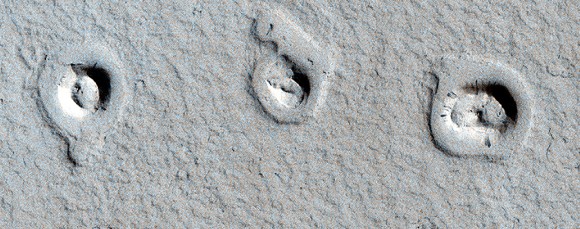Welcome to DU!
The truly grassroots left-of-center political community where regular people, not algorithms, drive the discussions and set the standards.
Join the community:
Create a free account
Support DU (and get rid of ads!):
Become a Star Member
Latest Breaking News
General Discussion
The DU Lounge
All Forums
Issue Forums
Culture Forums
Alliance Forums
Region Forums
Support Forums
Help & Search
Science
Related: About this forumHieroglyphic-like Features Point to Past Subsurface Water on Mars

These unusual shapes on Mars surface are actually cones and inflated lava flows, Credit: NASA/JPL/University of Arizona.
Although these strange features on Mars look a bit like hieroglyphics or geoglyphs such as the mysterious Nazca lines on Earth, they are completely natural features, ones that are found on Earth too.
Called ‘rootless cones,’ they form on lava flows that interact with subsurface water or ice. Their formation comes from an explosive interaction of lava with ground ice or water contained within the regolith beneath the flow. Vaporization of the water or ice when the hot lava comes in contact causes an explosive expansion of the water vapor, causing the lava to shoot upward, creating a rootless cone.
Dr. Alfred McEwen, HiRISE Principal Investigator, described the ancient lava flow as ‘inflated.’ “Lava inflation is a process where liquid is injected beneath the solid (thickening) crust and raises the whole surface, often raising it higher than the topography that controlled the initial lava emplacement,” he wrote on the HiRISE website.
The scene above is located in Amazonis Planitia on Mars, a vast region covered by flood lava. McEwen said if this image were in color, we’e see the surface is coated by a thin layer of reddish dust, which avalanches down steep slopes to make dark streaks.
Similar features are found in Iceland, where flowing lava encountered water-saturated substrates.
Read more: http://www.universetoday.com/100142/hieroglyphic-like-features-point-to-past-subsurface-water-on-mars/
InfoView thread info, including edit history
TrashPut this thread in your Trash Can (My DU » Trash Can)
BookmarkAdd this thread to your Bookmarks (My DU » Bookmarks)
1 replies, 1137 views
ShareGet links to this post and/or share on social media
AlertAlert this post for a rule violation
PowersThere are no powers you can use on this post
EditCannot edit other people's posts
ReplyReply to this post
EditCannot edit other people's posts
Rec (2)
ReplyReply to this post
1 replies
 = new reply since forum marked as read
Highlight:
NoneDon't highlight anything
5 newestHighlight 5 most recent replies
= new reply since forum marked as read
Highlight:
NoneDon't highlight anything
5 newestHighlight 5 most recent replies
Hieroglyphic-like Features Point to Past Subsurface Water on Mars (Original Post)
n2doc
Feb 2013
OP
DreamGypsy
(2,252 posts)1. Interesting. When I first saw the photo and hadn't read the text...
...I thought that the shapes looked like small scale features, maybe more closeups taken by Curiosity...precise, neatly aligned, sharply defined shapes embossed on the soil.
However, since the image is from a reconnaissance orbiter, the scale is obviously much larger, but how large. Could be thousands or hundreds or possibly tens of meters in diameter. The universe today article didn't offer any clues to the size, neither could I find information on the HiRISE site.
A search for 'rootless cones mars' got me Planetary Science Research Discoveries and an article entitled If Lava Mingled with Ground Ice on Mars from 2001.
Clusters of small cones on the lava plains of Mars have caught the attention of planetary geologists for years for a simple and compelling reason: ground ice. These cones look like volcanic rootless cones found on Earth where hot lava flows over wet surfaces such as marshes, shallow lakes or shallow aquifers. Steam explosions fragment the lava into small pieces that fall into cone-shaped debris piles. Peter Lanagan, Alfred McEwen, Laszlo Keszthelyi (University of Arizona), and Thorvaldur Thordarson (University of Hawai`i) recently identified groups of cones in the equatorial region of Mars using new high-resolution Mars Orbiter Camera (MOC) images. They report that the Martian cones have the same appearance, size, and geologic setting as rootless cones found in Iceland. If the Martian and terrestrial cones formed in the same way, then the Martian cones mark places where ground ice or groundwater existed at the time the lavas surged across the surface, estimated to be less than 10 million years ago, and where ground ice may still be today.
<snip>
Cone-shaped structures on the Martian volcanic plains were first identified and interpreted as rootless cones in the 1970s with Viking imagery. Their occurrences were reported in Chryse Planitia, Deuteronilus Mensae, Acidalia Planitia, Isidis Planitia, and Elysium Planitia. Using the higher-resolution MOC images, Lanagan and colleagues identified cones in the Cerberus plains, Marte Valles, and Amazonis Planitia. The cones appear to be superimposed on the surface of low volcanic plains near recognized outflow channels. Using crater counts and other geologic evidence, William Hartmann (Planetary Science Institute) determined the lava flows may be as young as 10 million years.
<snip>
The cones seen in the MOC images have base diameters ranging in size from 20 meters to 300 meters. Summit craters on the cones have diameters about half as wide as the bases. Martian cones are found in clusters ranging from a few to many hundreds of cones. These dimensions and arrangements are consistent with explosive rootless cones found in Iceland.
Here's what rootless cones look like in Iceland:

Odd, no signs of the greenery or rectangular building structures in the HiRISE images. Hmm.
Thanks for the post, n2doc.